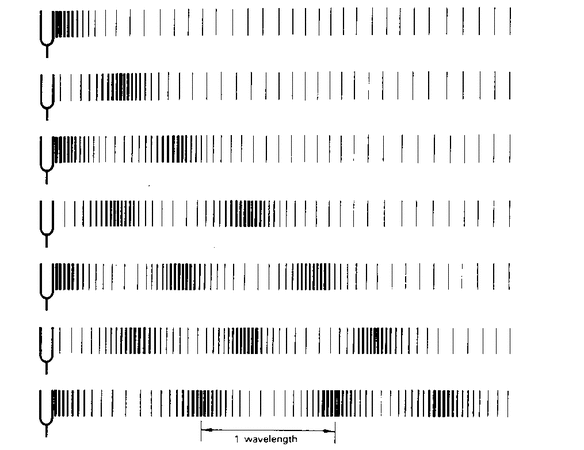Below is an excerpt from a blog post on my personal blog. For the entire post (and other posts as well) go to my personal site.

Guitars are great instruments, they're fun to play, and they sound incredible. But, most importantly (for our purposes at least), the physics of guitars is really interesting. It's also more complex than you may have thought; most people assume that the guitar strings vibrate air, and that's pretty much it. But there's a lot more going on, and we'll explore all of the interesting phenomena that make a guitar's sound possible. First, though, we'll need get a clearer idea of sound. After that, we'll be ready to delve into the mechanisms that help guitars produce their characteristically sweet music.
Sound
There are two very closely related perspectives that I (and most people) use to explain sound. One way to explain sound uses air pressure (which is basically a measurement of the density of air, or how close air molecules are). The air pressure explanation says that sound is just alternating regions of higher and lower air pressure. For example: you can actually see a speaker which plays a low note move, right? What it's doing is compressing the air next to it, thus raising its pressure. Some of that air keeps going, compressing the air next to it, and so on like that.
I prefer looking at it more through a molecule perspective, though (as you may have noticed in my first post). Sound is just molecules of air pushing against one another in a chain reaction. An example to better illustrate what I mean is a slinky, lying on the ground, which you push sideways. The first 'ring', or section, of the slinky that you push will push the one next to it, which will push the next one down, and so on like that. For sound, what happens is that something (like a speaker) pushes the air molecules next to it, and the motion is transferred through the air. The picture below illustrates both the molecule and the air pressure perspective (each little line can be thought of as an air molecule), and the origin of the sound, or what first pushes the air molecules, is a tuning fork. You can see that at some points, the molecules are more densely packed (alternatively, you could say that they're densely packed because the left ones are pushed forward).
I prefer looking at it more through a molecule perspective, though (as you may have noticed in my first post). Sound is just molecules of air pushing against one another in a chain reaction. An example to better illustrate what I mean is a slinky, lying on the ground, which you push sideways. The first 'ring', or section, of the slinky that you push will push the one next to it, which will push the next one down, and so on like that. For sound, what happens is that something (like a speaker) pushes the air molecules next to it, and the motion is transferred through the air. The picture below illustrates both the molecule and the air pressure perspective (each little line can be thought of as an air molecule), and the origin of the sound, or what first pushes the air molecules, is a tuning fork. You can see that at some points, the molecules are more densely packed (alternatively, you could say that they're densely packed because the left ones are pushed forward).

 RSS Feed
RSS Feed